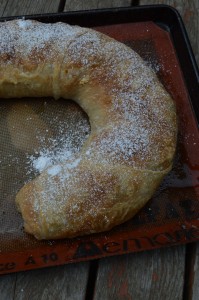 The most common form of strudel in North America is puff pastry filled with sticky jam or compote, the final product very similar to a turnover or a chausson.
The most common form of strudel in North America is puff pastry filled with sticky jam or compote, the final product very similar to a turnover or a chausson.
The original strudel, the Viennese strudel, is a different beast entirely.
Austrian strudel is made with a simple dough consisting of flour, salt, water, and vegetable oil. High protein flour is used, and the dough is mixed extensively so that there is intensive gluten development. This allows the baker to stretch the dough until it is so thin it is almost transparent. The expression in Austrian kitchens is that the dough should be thin enough that you could hold the dough over a newspaper and read the text through the dough. … Continue reading.
Another example of how to use the custards I’ve been talking about.
Come to think of it, most of the posts this advent have been short, simple introductions to basic pastry preparations: whipped cream, for instance, and ganache. Now we can start combining some of those building blocks to make more elaborate preparations.
Take éclairs. Éclairs are long choux pastries filled with whipped cream or pastry cream, glazed with chocolate.
We discussed choux pastry here, whipped cream here, pastry cream in this post, and ganache in this one. Several birds, one stone.
I ate my fair share of éclairs growing up. My dad often brought them home on Saturday mornings from the doughnut shop in the … Continue reading.
 The doughnut: an important food that for most of my life I have known only in its commercial form. Other examples of such food include hot dogs, ketchup, and potato chips.
The doughnut: an important food that for most of my life I have known only in its commercial form. Other examples of such food include hot dogs, ketchup, and potato chips.
Until recently, every doughnut I had eaten was commercially produced. On top of that, the only freshly-fried doughnuts I had eaten were the mini-donuts at the Calgary Stampede, and a few Krispy Kremes.
As you might expect, the homemade version is vastly superior, especially when consumed within ninety seconds of being removed from the oil.
What would a Button Soup post be without some mention of spelling or etymology? For the longest time I assumed these pastries were originally called “doughnaughts,” as in naughts (zeroes) made out of dough, … Continue reading.
The personal website of Edmonton chef Allan Suddaby
 The most common form of strudel in North America is puff pastry filled with sticky jam or compote, the final product very similar to a turnover or a chausson.
The most common form of strudel in North America is puff pastry filled with sticky jam or compote, the final product very similar to a turnover or a chausson.